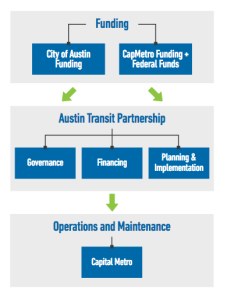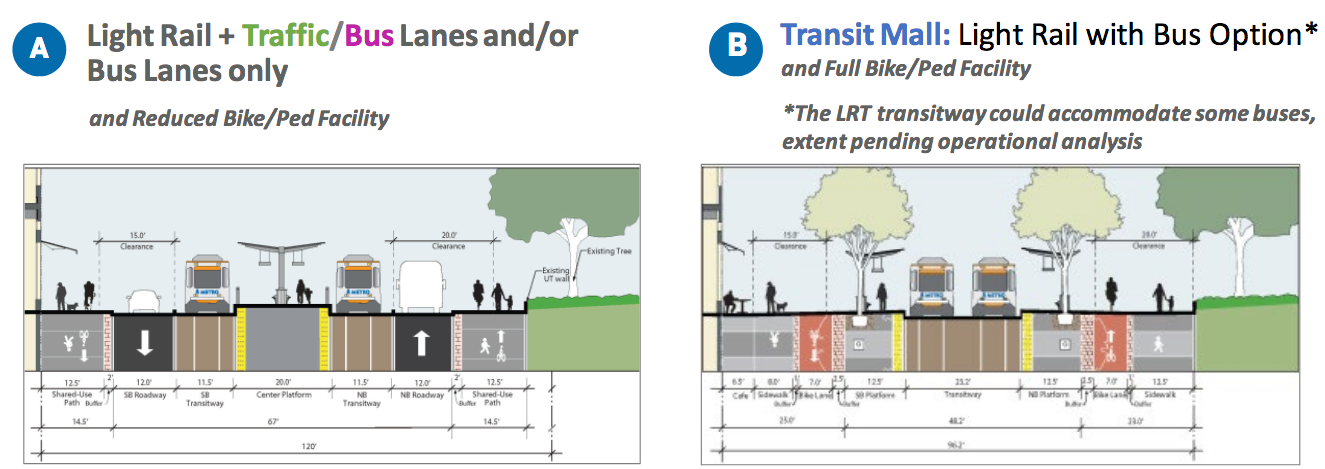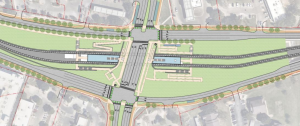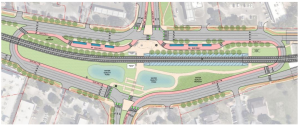Billions of dollars to be spent on mass transit plan Project Connect
The Austin City Council and the two transit organizations implementing Project Connect are gearing up to make decisions about the design of two light rail lines that could shape the geography of Austin for generations.
Project Connect calls for two light rail lines in its first phase, and a third commuter rail line at a later stage, plus expansion of the bus system and the acquisition of an all-electric, zero-emissions bus fleet.
Planners have been working toward completion of a key milestone, the 30 percent design for the new Orange and Blue rail lines. They aim to hit that milestone in November, with final board approval in December, according to a timetable presented at a March 2nd work session of the Austin Transit Partnership (ATP), a local government corporation.
After that it will become more difficult to change the plans without upending the timetable for construction. In early 2023, ATP will submit the plans to the Federal Transit Administration (FTA) for environmental vetting and evaluation for matching funds. ATP hopes for a final grant agreement by mid-2024.
That means that this year is really the last chance for community input on design choices that will be difficult or impossible to change later. In recent months, Project Connect’s outreach team has held community meetings to brief the public and solicit feedback on some of the tougher design choices—an effort that will intensify in the spring.
Among the decisions to be made, for example, is whether to dig an underpass for a rail station at Pleasant Valley and East Riverside, which would be better for pedestrians and traffic flow, or to use a lower-cost roundabout design. Another question is what the Blue Line bridge across Lady Bird Lake should look like. Should it be a standalone bridge for the train only, or does it make sense to include pedestrian and bus lanes too?
Who’s who in the process
Three government entities are involved in making these decisions: the Austin City Council, Capital Metro (the Austin area transit authority, which is also called CapMetro), and the Austin Transit Partnership (ATP). These three organizations are intertwined through overlapping boards and governance structures, but they have distinct roles.

ATP is responsible for Project Connect’s design, engineering, construction, and procurement of right-of-way and equipment. CapMetro will operate the transit infrastructure once it’s completed. And the City’s role is to provide oversight and funding to ATP, which it jointly created with CapMetro in December 2020. The City is also tasked with managing anti-displacement investments associated with Project Connect.
Additionally, the City will play an important role in negotiating and approving changes to street layouts, utilities, and other infrastructure that will be affected by the new railways. At its March 24th meeting, the council is scheduled to vote on a $3 million contract to provide engineering services for Project Connect to assess how city water and wastewater pipes could be affected by Project Connect’s downtown transit tunnel.
Austin levies a voter-approved property tax of 8.75 cents per $100 of value on behalf of ATP, which is expected to generate $155 million in revenue for the transit agency this year, according to its budget. ATP plans to use this revenue as a pledge for repayment of bonds that it will issue to pay for the rail project, together with federal loans and grants. CapMetro, which is funded through fare revenue and a 1 percent sales tax, will also contribute to the effort.

The Federal Transit Administration (FTA) has already accepted ATP’s light rail proposals into project development, a major step toward eventual grant awards. Next year, it will evaluate the projects for discretionary funding and assign a rating in August on a five-point scale, according to Randy Clarke, who is CEO of both CapMetro and ATP.
He said, “For the FTA, August is a firm (deadline), there is no wiggle room in that. That’s their process every year, because if it’s not in the rating in August it can’t get in the president’s proposed budget for the following year.”
“It’s a fairly aggressive schedule. That’s why we built so much community process at the front end, so we can really get toward consensus as we get to the end versus trying to solve something later in the fall.”
Wade Cooper, a CapMetro board member and former chair, said, “We’re on a super tight time frame right now. We really have to keep our eye firmly on the finish line, which is really about us getting to a consensus by the end of this year on these major issues.”
According to Dottie Watkins, Deputy CEO of CapMetro, the three organizations already agree on the “vast majority” of design issues, and will use community input in coming months to resolve thornier questions.
Community weighs in on design
ATP’s public outreach on design topics began last fall with a series of virtual workshops. These meetings typically consist of a briefing followed by an opportunity for discussion, questions, and structured input through a survey or questionnaire.
For example, ATP held a community design workshop December 14th to discuss options for right-of-way along 4th Street between Republic Square and the Convention Center, where two light rail lines and three commuter bus lines are expected to converge. According to a presentation given at the event, ATP’s preliminary designs call for making a six-block stretch of 4th Street “pedestrian dominant,” while still supporting the circulation of buses.
Another meeting January 12th discussed the likelihood that the Waller Creek Boathouse will be torn down. The boathouse, which is the home of the Austin Rowing Club, lies in the path of the Blue Line as it would emerge from a tunnel along Trinity Street before crossing Lady Bird Lake on a bridge. ATP staff presented six options for where the boathouse could be relocated.
Another two meetings held in February discussed how North Guadalupe Street would be affected by the addition of rail lines, including at the 29th Street intersection and on The Drag, the commercial area at the western edge of the University of Texas at Austin. The February 24th meeting focused on the planned UT West Mall station, which would be built on The Drag in the middle of Guadalupe Street.
ATP staff presented two basic options for the station: a center-platform station flanked by two vehicle lanes, or a rail-only option, with expanded sidewalk and bike space plus room for street-side cafes.

In the first scenario, passengers would need to cross a roadway and rail track to get to the center platform to board the train. The number of general-use travel lanes (for cars) would be cut from the current four to two, and a lane for parallel parking lane would also be removed. In the second scenario, passengers would board from side platforms, with the two rail lines running in tandem down the middle of the street. There would be no travel lanes for cars, though optionally the trains could use embedded rails, enabling them to share the guideway with buses.
More recently, ATP hosted a virtual meeting about the MetroCenter Station, which ATP originally planned to locate at MetroCenter Drive near the airport, but now intends to place farther to the west on East Riverside Drive. Participants were briefed on the reasons for the change as well as four possibilities for the location of a nearby park-and-ride. Some asked questions about bike and pedestrian access, and others offered ideas for giving the station a different name.
Videos of these meetings and accompanying presentations are available here.
Upcoming meetings
Two webinars will take place March 29th and March 31st to provide an overview of Project Connect and preview different design topics. Breakout sessions will cover environmental considerations, connectivity, anti-displacement investments, and traffic impacts, according to the agenda.
A community design workshop for the Crestview Station will take place April 11th, hosted by Council Members Leslie Pool and Jose “Chito” Vela. Later in April and May, ATP will facilitate workshops about the South Congress Station, Lady Bird Lake Bridge, the Pleasant Valley/East Riverside Station, the Drag, and different options for a maintenance facility site, according to a timeline presented at the March 2nd board meeting.
Additional meetings in June will focus on the downtown subway, the Auditorium Shores Station, Republic Square Station, and the trains themselves. However, specific dates for these meetings haven’t yet been announced.

“This is a really key moment in the process,” said Peter Mullan, ATP, Chief of Architecture and Urban Design at Austin Transit Partnership, at a February 24th community design workshop. “This is really an important time and your feedback will make a big difference.”
Other Project Connect components
The Orange Line and Blue Line won’t be finished until about 2029, according to Project Connect’s original timetable. In the meantime, several smaller Project Connect components are moving forward along separate schedules, and will be ready sooner.
One of these is a new station at McKalla Place, located on the existing Red Line commuter rail next to the Austin FC soccer stadium. The designs for that station are complete and a groundbreaking will take place this summer. Austin FC will contribute $3.6 million toward the cost of the $24 million station, under a deal struck when the team first moved to the city.
Nearby, another Red Line station, Broadmoor, is being added at Uptown ATX, a new 66-acre mixed-use development. However, that station is not part of Project Connect but is funded through a public-private partnership between Brandywine Realty Trust and CapMetro.
Construction of new MetroRapid bus infrastructure is also underway. These are high-frequency routes with limited stops. Officials held a groundbreaking ceremony December 15th at LBJ Early College High School, which will serve as a stop on a new 12-mile line from the eastside Expo Center to UT and downtown. They held a second groundbreaking February 16th for another 14-mile MetroRapid line that will run from Mueller to Pleasant Valley and beyond. In all, four MetroRapid routes are planned as part of Project Connect, with service expected to begin in 2023.
A promise deferred
Finally, Project Connect also features an anti-displacement program, which is fraught with political importance. This $300 million program was included in the initial investment plan approved the City Council in July 2020, and was also promised to voters in the ballot language of Proposition A, the November 2020 tax election that initiated Project Connect.
The proposition passed resoundingly by a vote of 57.9 percent to 42.1 percent. That outcome suggested that Project Connect was widely embraced by Austinites worried about climate change, sprawl, and traffic congestion—all of which had been talking points during the campaign.
But the proposition also had raised worries, including among Democrats, about how it would affect housing costs in the city. According to the city’s own calculations at the time, the extra property tax of 8.75 cents per $100 of valuation would result in an extra $351 tax each year for the average homestead. Critics argued this would make the city less affordable and accelerate the displacement of established Black and Hispanic households, a process sometimes referred to as gentrification.
Proponents sought to alleviate such concerns by pointing to the promised anti-displacement investments. The Austin Justice Coalition, which supported Proposition A, acknowledged in a position paper that “increasing property values around new transit stations has the potential to exacerbate both residential and commercial gentrification, and associated displacement processes.” Nevertheless, this could be countered through a “mobility justice framework” that included tools like land trusts, rental assistance, and limited equity cooperatives, it said.
However, the anti-displacement component of Project Connect has been slow to get underway. Last year, the new transit tax generated $23 million for anti-displacement purposes, but the City spent none of those funds.
Likewise, so far this fiscal year, which began in October, the City hasn’t made any anti-displacement investments, though it has announced a plan for how it will allocate $65 million (an amount equivalent to the total of the program’s budgets for FY 2021 and FY 2022.)
An additional allotment of $35 million will be available in FY 2023, and $20 million in each of the subsequent 10 years, according to an interlocal agreement between the city and ATP.
The city has formed an 11-member Community Advisory Committee to help decide how these funds will be spent. It has also established a Project Connect Office with dedicated staffing to oversee the initiative.
 Trust indicators: Bulldog reporter Daniel Van Oudenaren is a journalist with 13 years experience in local, state, and international reporting.
Trust indicators: Bulldog reporter Daniel Van Oudenaren is a journalist with 13 years experience in local, state, and international reporting.
Related Bulldog coverage:
Price tag for CapMetro buses tops $1 million apiece, September 29, 2021
Austin Transit Partnership approves $312.8 million budget, September 17, 2021
Transit tax draws attack from the left, October 2, 2020
Links to related documents:
Timetable for Orange/Blue Line decision-making, March 2, 2022 (1-page graphic)
Interlocal agreement for the creation of Austin Transit Partnership, September 18, 2020 (10 pages)
Amendment to the ATP interlocal agreement, April 30, 2021 (3 pages)
ATP Articles of Incorporation, December 18, 2020 (9 pages)
Bylaws of the Austin Transit Partnership, December 18, 2020 (7 pages)
Council resolution to create the Austin Transit Partnership, December 18, 2020 (21 pages)
Capital Metro Resolution for funding and commitment for Project Connect, August 24, 2020 (7 pages)
Project Connect System Plan, Initial Investment, adopted June 10, 2020 (1-page graphic)










Why not use the MOPAC tracks? Build a freight line around the city and swap with Missouri Pacific.